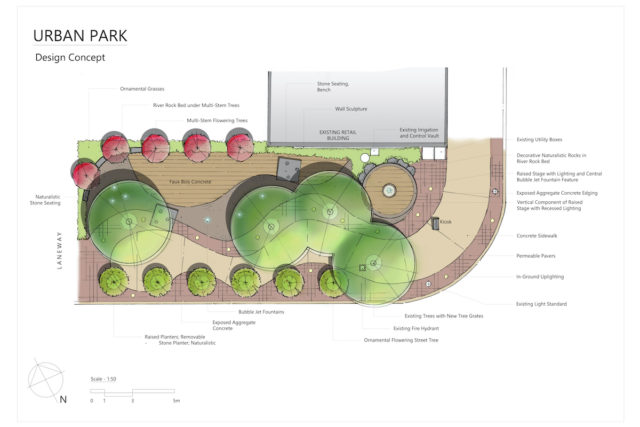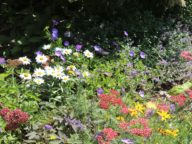[Editor’s Note: When God created the world, he saw that “it was good.” In this series, we want to explore how our faith in Jesus helps us celebrate and enjoy what’s good in creation––but also work as stewards to help it thrive to its fullest potential. Caring for our planet, including plants and animals, fungi and microbes, ecosystems and people, is a high calling from God––a calling in which we can engage out of love and not fear. The gospel gives us hope that what is broken can be restored, and even now, we can enjoy what has been given to us. Join us as we #celebratecreation.
This interview is with Sarah Cooper, a landscape architect in London, ON. She is a full member of the Ontario Association of Landscape Architects and the Canadian Society of Landscape Architects. When not working, Sarah enjoys reading, yoga, runs with her husband, and snuggle time with her tuxedo kitty, Lily.]
P2C-Students: How and why did you become a landscape architect? And what is landscape architecture anyways?
Sarah Cooper: Growing up at the foot of the Niagara Escarpment in Owen Sound, Ontario, I became aware at a young age of my love for nature. I was drawn to landscape architecture by its promise of creativity backed by scientific process, and the chance to design cities for the betterment of the people and natural systems within them. While most people assume that my days are occupied with designing exuberant pools in backyards and immaculate planting displays in front yards, my work actually focuses on larger scale projects like parks, trail networks, downtown streetscapes, and urban plazas!
Landscape architecture can be simply described as a profession that focuses on design with nature. More descriptively, a landscape architect uses artistic principles and scientific knowledge to design both natural and built environments that are beautiful and functional. It is my professional goal to design places that allow both people and nature to thrive together.
A landscape architect uses artistic principles and scientific knowledge to design both natural and built environments that are beautiful and functional.
P2C-S: How has this profession changed the way you see the world around you?
Sarah: Learning design theory in university changed the way I saw everything. Since then, I’ve developed a tendency to consider the opportunities and constraints in every setting. I question the “why” of how places are laid out, the materials used, and, for outdoor settings, the plant species selected. I don’t think I’ve ever been to a patio where I haven’t wondered about the microclimate considerations that went into the orientation of the space. In a natural setting, it’s the same story. Hopefully, my husband will never get tired of hearing me call out every species of tree on our hikes!
P2C-S: How has your Christian faith changed the way you see the natural world?
Sarah: As God’s creation (me), designing with God’s creation (nature), I feel a strong sense of responsibility to create designs that preserve and enhance the natural world.
P2C-S: As you design with God’s creation, what helps you remember the value of the natural world, rather than seeing it as disposable?
Sarah: My professional focus is on design for the betterment of people and nature. A plethora of scientific studies have shown that exposure to nature has countless benefits for human well-being. In this way, designing for nature’s health also means designing for human health.
When designing for nature’s health, ideally my team and I will spend time at the beginning of a project to observe, record, and consider the natural attributes of the landscape. This foundation will allow us to enhance and protect the site’s natural character and systems. Although some of my projects budget for this initial investigation, unfortunately many developers do not take this kind of care.

P2C-S: How do you balance the sometimes competing priorities of what humans want and what an ecosystem needs? What does caring for the environment look like when you have a small budget?
Sarah: In the few years that I’ve been working, I’ve learned that very rarely are the priorities of humans aligned with the needs of an ecosystem. Humans often prioritize things that make money, and although it’s been proven that monetary value can be assigned to natural areas, this value is not immediate or tangible enough to convince most people. Instead, healthy ecosystems seem costly because they require space, often expensive enhancements, and most importantly time.
As a professional who understands both the needs of people and nature, my role is uniquely positioned to help bridge this gap. I do “speak for the trees,” like the Lorax, but I also balance this with the importance of city growth. My goal is that this would be healthy growth that prioritizes both people and nature. I believe that our cities can and should be developed in ways that assume interconnection, rather than a disconnect. We should be continually looking for ways to balance human development and the preservation (and even enhancement) of the natural world. My job as a landscape architect puts me in the unique position to help our cities reach this balance.
We should be continually looking for ways to balance human development and the preservation (and even enhancement) of the natural world.
P2C-S: How much can humans actually add balance and beauty to the world?
Sarah: I consider all my designs as opportunities to add beauty to the world. I love that God has allowed us to be co-creators. Our Father is creative and has made so much beauty to inspire and give joy. And he gave us the ability to be creative. Although we did not create the palette and brush, he gives us these tools and asks us to paint. This is what designing feels like to me, and I know that by doing so, I’m using the gifts he’s given me. Whether I’m working on a large, high-budget urban project or a small planting plan for a townhouse complex, I am creating a space through which someone else will see the world, and my hope is that for them, it is beautiful.
P2C-S: Why does beauty matter in the places where we live?
Sarah: I believe humans were created for beauty, because we were created by and for God, who is the ultimate definition of beauty. God’s creation is beautiful, and if he thought it was important, then I’m inclined to agree.
Beauty is important for our health and well-being. When we are immersed in a beautiful landscape, a sunrise, or even a painting of pristine rolling hills, we feel lighter. These lift our spirits, encourage us, help us relax, and slow our breathing. And while beauty may be considered subjective, a study found that when children were asked to draw their favourite place, 96% of them drew a natural space. If you don’t agree that nature is beautiful, I don’t know what more to say.
P2C-S: What are some simple things that the average person could do in their own yards, balconies, or communities to contribute positively to the landscapes around them?
Sarah: Planting a pollinator garden is a simple and beautiful way to help bees and butterflies (and more) survive in your area. Urban cities in particular are like deserts to these species. Yet we rely on pollinators for much of our produce. In fact, a third of our food, including your morning cup of coffee, depends on bee pollination alone! Give back some of your space by planting pollinator-friendly native plants around your property. A few of my favourites are lupins, bee balm, and coneflower. A quick internet search will give you more than enough ideas! Most importantly, you’ll be helping to support the health of your local ecosystem, which in turn gives back to you.
"*" indicates required fields





